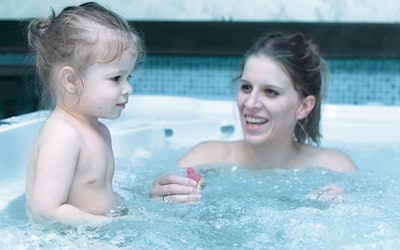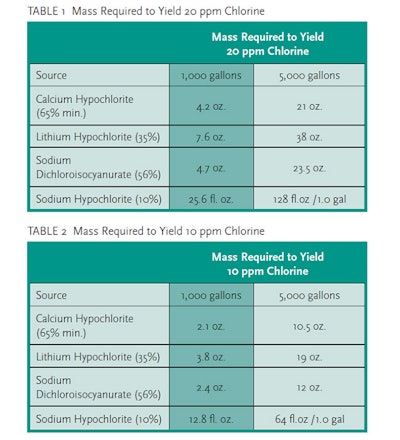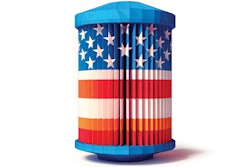
Contamination of small vessels of water can take many forms, including slime, cloudy water, musty odors, vomit, and feces among others. Buildup of contaminants can result in threats to bather health, which can include rashes, flu-like symptoms, diarrhea, respiratory distress or worse. Therefore, a water replacement strategy enabling the complete decontamination of the vessel should be part of the preventative maintenance schedule. Water replacement is more viable due to the small scale of these aquatic environments. If a user/operator suspects a high level of contamination, prudence demands a thorough cleaning to avoid risk to bathers.
If the water is indeed contaminated, that means the plumbing system and filter are likely to be harboring bacteria, viral particles and/or parasitic pathogens and should be addressed. Therefore, the replacement of water alone is not sufficient. The vessel shell and its filtration/circulation systems should be completely decontaminated as well.
This is a generic overview of procedures that can be used for the decontamination or annual maintenance of spas, hot tubs, swim spas and wading (kiddie) pools while bathers are not present. If used for decontamination, the user/operator should check existing local or state regulatory agency guidelines. The following recommendations do not replace existing state or local guidelines. In the absence of regulatory agency guidelines, please refer to CDC Healthy Swimming recommendations.
Step 1: Personal precautions
To minimize exposure to potentially harmful pathogens and disinfection by-products during the decontamination procedure, the person performing the decontamination procedure should consider using the following Personal Protective Equipment (PPE):
- Appropriate air purifying respirator
- Goggles/eye protection
- Gloves
- Any other PPE specified by the manufacturers of products being used in the decontamination procedure
Step 2: Removal of Contaminants
Feces, vomit, scums, foams, and/or any other pollutants should be removed with an appropriate accessory (net, brush, etc.).
Step 3: Tool Cleaning
Insure any tool that was used in the water is properly disinfected before using again.
Step 4: Decontaminating Filters
Cartridge Filters: First, remove the filter cartridge and either clean or replace it. To clean a cartridge, first use a filter cleaner per label directions. After thoroughly rinsing the cartridge, completely submerge the cartridge in a 1:10 solution of sodium hypochlorite (liquid bleach) to water for one to four hours. Next, inspect and clean the filter-housing interior and all surfaces where possible using a 1:10 solution of sodium hypochlorite to water.
iatomaceous Earth Filters: First, backwash filters removing all D.E. housing and grids. Dispose of D.E. according to local regulatory guidelines. If guidelines do not exist, use CDC standards for disposal. Wash remaining D.E. from housing and all filter grids. Where possible, remove and submerge filter grids in a 1:10 solution of sodium hypochlorite to water for one to four hours. Inspect and clean the filter housing interior using a 1:10 solution of sodium hypochlorite to water. Install filter grids after spa decontamination is complete.
Sand Filters: Backwash the filter thoroughly according to local regulatory guidelines. Remove and dispose of the sand filter media1. Check the filter laterals and diffuser to determine any damage. Replace as required.
Step 5:
For spas, raise the water level to ½ inch above the high water mark.

Step 6:
For diarrheal discharge or suspected bacterial outbreak (e.g. Legionella, Pseudomonas): Maintain 20 ppm free available chlorine and 7.5 pH2.
See Table 1 for dosage charts and use appropriate test kit or strips to confirm level was continually achieved. For formed stool: Maintain 10 ppm free available chlorine and 7.5 pH.
See Table 2 for dosage charts and use appropriate test kit or strips to confirm level was continually achieved.
Step 7:
Circulate the water under diarrheal discharge conditions for 12.75 hours and for spas, ensure the jets are on maximum.
For spas: While the water is circulating under the diarrheal discharge condition, turn the aerator (blower) on for 30 seconds every 5 minutes for at least one hour. Spas with air injector (venturi) systems may require the pump alternating operation from on to off every 5 minutes to ensure the disinfection of the air lines.
Circulate the water under formed stool conditions for 4.5 to 5 minutes and for spas, ensure the jets are on maximum.
Step 8:
Stop the circulation in spas by turning the jets and aerator off.
Step 9:
Check local regulatory guidelines before draining, then drain vessel and rinse the sides during the process.
Step 10:
Clean the shell with a surface cleaner, and rinse off surfaces to remove cleaner.
Step 11:
Remove any excess water and cleaner.
Step 12:
Refill the vessel with water.
Step 13:
Replace the filter with a cleaned, sanitized, or new filter cartridge, fresh sand, or DE.
Step 14:
Balance water and sanitize as required by state or local guidelines. In the absence of these, use ANSI/APSP or CDC Healthy Swimming recommendations.
Step 15:
Complete documentation required by local or state entities. In the absence of local or state requirements, use CDC recommendations in cases involving an Accidental Fecal Release (AFR) accident.
Footnotes1 When following the Decontamination Procedure as part of normal spa maintenance, sand replacement may not be necessary. Draw down the water to the sand surface and inspect for cracks, mounds or signs of channeling. Any of these features can signal a need to change the sand. |







































